Analyzing the Public Health Crisis of Ebola in 2014-2015
VerifiedAdded on 2020/05/04
|14
|4066
|199
AI Summary
This report delves into the 2014 outbreak of the Ebola virus in Guinea, Sierra Leone, and Liberia, highlighting its severe impact on public health. The document explores how the virus spreads through close contact with bodily fluids and the role zoonotic sources like fruit bats play in its transmission. It emphasizes the importance of stringent hygiene practices and global cooperation for containment. Public health responses included international travel restrictions, quarantine measures, and heightened awareness efforts to prevent further spread. Genomic surveillance played a critical role in tracing the virus's origins and movement. The study stresses the necessity of robust healthcare systems and rapid response protocols to manage such outbreaks effectively.
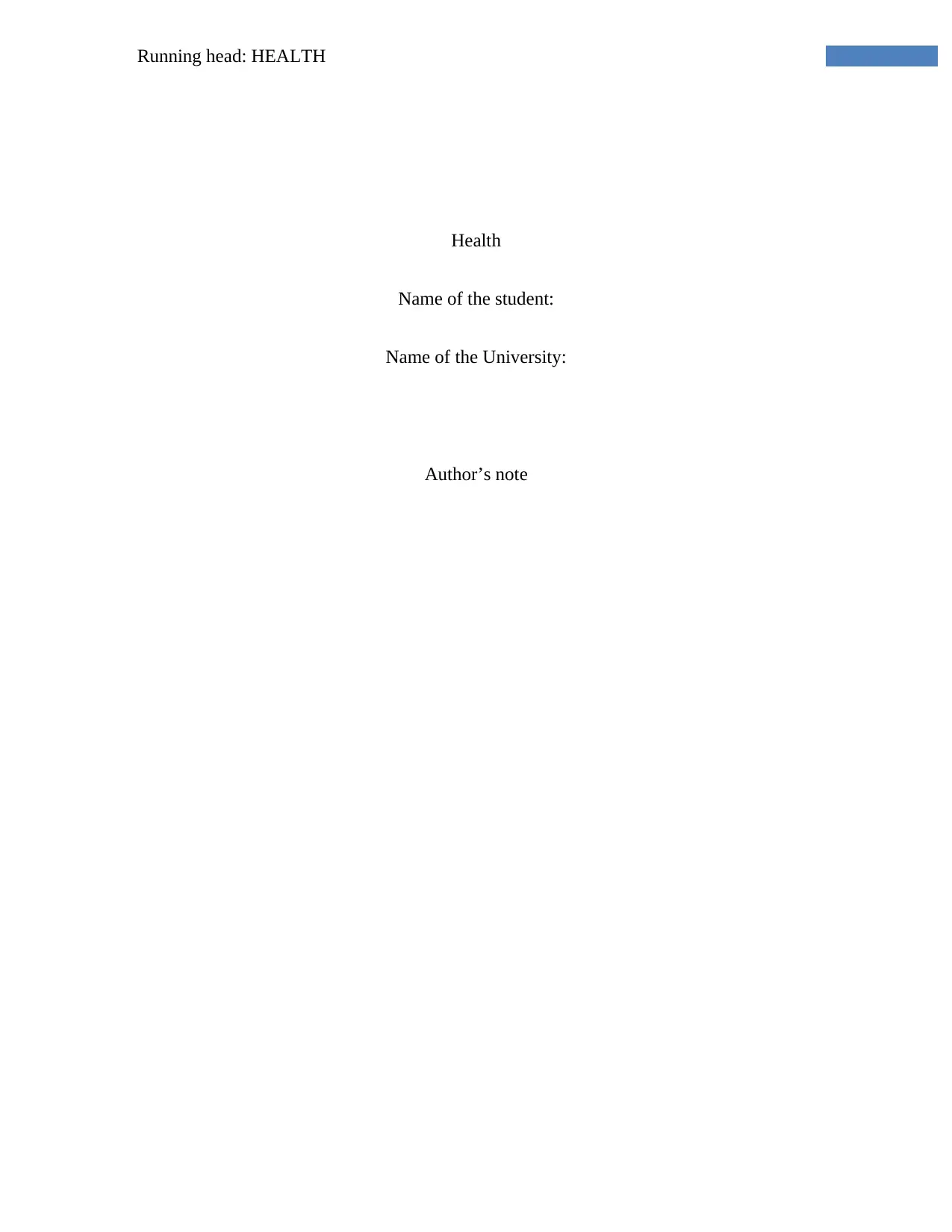
Running head: HEALTH
Health
Name of the student:
Name of the University:
Author’s note
Health
Name of the student:
Name of the University:
Author’s note
Paraphrase This Document
Need a fresh take? Get an instant paraphrase of this document with our AI Paraphraser
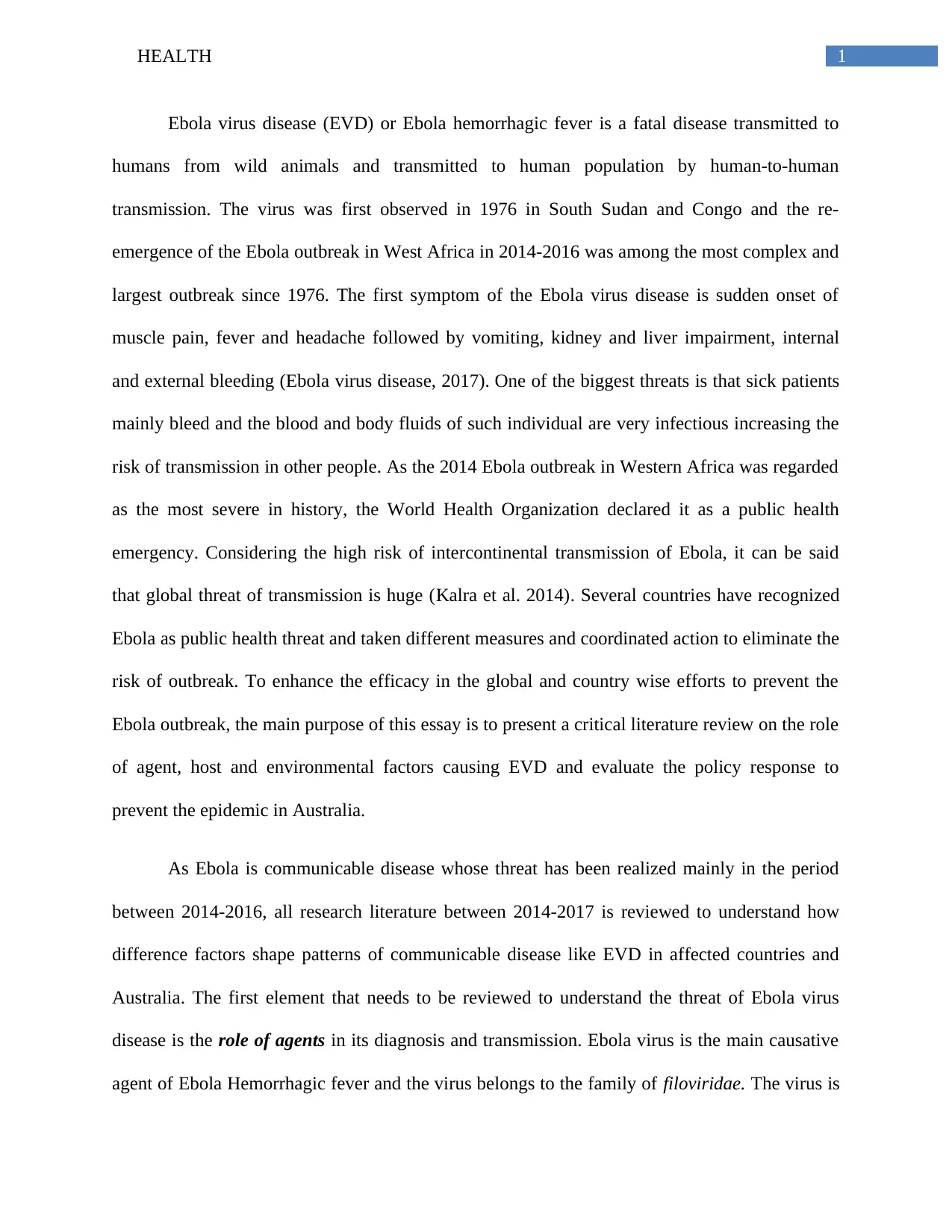
1HEALTH
Ebola virus disease (EVD) or Ebola hemorrhagic fever is a fatal disease transmitted to
humans from wild animals and transmitted to human population by human-to-human
transmission. The virus was first observed in 1976 in South Sudan and Congo and the re-
emergence of the Ebola outbreak in West Africa in 2014-2016 was among the most complex and
largest outbreak since 1976. The first symptom of the Ebola virus disease is sudden onset of
muscle pain, fever and headache followed by vomiting, kidney and liver impairment, internal
and external bleeding (Ebola virus disease, 2017). One of the biggest threats is that sick patients
mainly bleed and the blood and body fluids of such individual are very infectious increasing the
risk of transmission in other people. As the 2014 Ebola outbreak in Western Africa was regarded
as the most severe in history, the World Health Organization declared it as a public health
emergency. Considering the high risk of intercontinental transmission of Ebola, it can be said
that global threat of transmission is huge (Kalra et al. 2014). Several countries have recognized
Ebola as public health threat and taken different measures and coordinated action to eliminate the
risk of outbreak. To enhance the efficacy in the global and country wise efforts to prevent the
Ebola outbreak, the main purpose of this essay is to present a critical literature review on the role
of agent, host and environmental factors causing EVD and evaluate the policy response to
prevent the epidemic in Australia.
As Ebola is communicable disease whose threat has been realized mainly in the period
between 2014-2016, all research literature between 2014-2017 is reviewed to understand how
difference factors shape patterns of communicable disease like EVD in affected countries and
Australia. The first element that needs to be reviewed to understand the threat of Ebola virus
disease is the role of agents in its diagnosis and transmission. Ebola virus is the main causative
agent of Ebola Hemorrhagic fever and the virus belongs to the family of filoviridae. The virus is
Ebola virus disease (EVD) or Ebola hemorrhagic fever is a fatal disease transmitted to
humans from wild animals and transmitted to human population by human-to-human
transmission. The virus was first observed in 1976 in South Sudan and Congo and the re-
emergence of the Ebola outbreak in West Africa in 2014-2016 was among the most complex and
largest outbreak since 1976. The first symptom of the Ebola virus disease is sudden onset of
muscle pain, fever and headache followed by vomiting, kidney and liver impairment, internal
and external bleeding (Ebola virus disease, 2017). One of the biggest threats is that sick patients
mainly bleed and the blood and body fluids of such individual are very infectious increasing the
risk of transmission in other people. As the 2014 Ebola outbreak in Western Africa was regarded
as the most severe in history, the World Health Organization declared it as a public health
emergency. Considering the high risk of intercontinental transmission of Ebola, it can be said
that global threat of transmission is huge (Kalra et al. 2014). Several countries have recognized
Ebola as public health threat and taken different measures and coordinated action to eliminate the
risk of outbreak. To enhance the efficacy in the global and country wise efforts to prevent the
Ebola outbreak, the main purpose of this essay is to present a critical literature review on the role
of agent, host and environmental factors causing EVD and evaluate the policy response to
prevent the epidemic in Australia.
As Ebola is communicable disease whose threat has been realized mainly in the period
between 2014-2016, all research literature between 2014-2017 is reviewed to understand how
difference factors shape patterns of communicable disease like EVD in affected countries and
Australia. The first element that needs to be reviewed to understand the threat of Ebola virus
disease is the role of agents in its diagnosis and transmission. Ebola virus is the main causative
agent of Ebola Hemorrhagic fever and the virus belongs to the family of filoviridae. The virus is
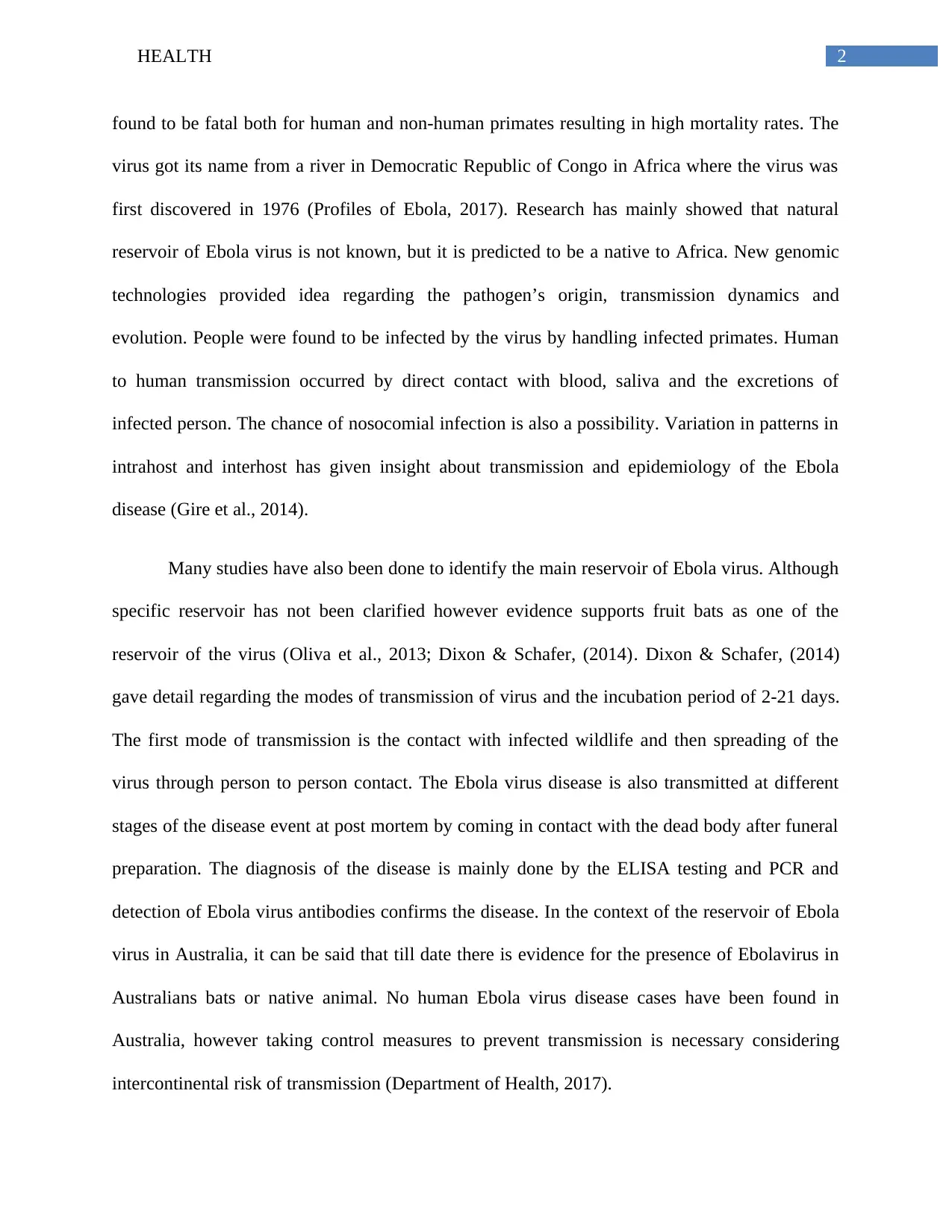
2HEALTH
found to be fatal both for human and non-human primates resulting in high mortality rates. The
virus got its name from a river in Democratic Republic of Congo in Africa where the virus was
first discovered in 1976 (Profiles of Ebola, 2017). Research has mainly showed that natural
reservoir of Ebola virus is not known, but it is predicted to be a native to Africa. New genomic
technologies provided idea regarding the pathogen’s origin, transmission dynamics and
evolution. People were found to be infected by the virus by handling infected primates. Human
to human transmission occurred by direct contact with blood, saliva and the excretions of
infected person. The chance of nosocomial infection is also a possibility. Variation in patterns in
intrahost and interhost has given insight about transmission and epidemiology of the Ebola
disease (Gire et al., 2014).
Many studies have also been done to identify the main reservoir of Ebola virus. Although
specific reservoir has not been clarified however evidence supports fruit bats as one of the
reservoir of the virus (Oliva et al., 2013; Dixon & Schafer, (2014). Dixon & Schafer, (2014)
gave detail regarding the modes of transmission of virus and the incubation period of 2-21 days.
The first mode of transmission is the contact with infected wildlife and then spreading of the
virus through person to person contact. The Ebola virus disease is also transmitted at different
stages of the disease event at post mortem by coming in contact with the dead body after funeral
preparation. The diagnosis of the disease is mainly done by the ELISA testing and PCR and
detection of Ebola virus antibodies confirms the disease. In the context of the reservoir of Ebola
virus in Australia, it can be said that till date there is evidence for the presence of Ebolavirus in
Australians bats or native animal. No human Ebola virus disease cases have been found in
Australia, however taking control measures to prevent transmission is necessary considering
intercontinental risk of transmission (Department of Health, 2017).
found to be fatal both for human and non-human primates resulting in high mortality rates. The
virus got its name from a river in Democratic Republic of Congo in Africa where the virus was
first discovered in 1976 (Profiles of Ebola, 2017). Research has mainly showed that natural
reservoir of Ebola virus is not known, but it is predicted to be a native to Africa. New genomic
technologies provided idea regarding the pathogen’s origin, transmission dynamics and
evolution. People were found to be infected by the virus by handling infected primates. Human
to human transmission occurred by direct contact with blood, saliva and the excretions of
infected person. The chance of nosocomial infection is also a possibility. Variation in patterns in
intrahost and interhost has given insight about transmission and epidemiology of the Ebola
disease (Gire et al., 2014).
Many studies have also been done to identify the main reservoir of Ebola virus. Although
specific reservoir has not been clarified however evidence supports fruit bats as one of the
reservoir of the virus (Oliva et al., 2013; Dixon & Schafer, (2014). Dixon & Schafer, (2014)
gave detail regarding the modes of transmission of virus and the incubation period of 2-21 days.
The first mode of transmission is the contact with infected wildlife and then spreading of the
virus through person to person contact. The Ebola virus disease is also transmitted at different
stages of the disease event at post mortem by coming in contact with the dead body after funeral
preparation. The diagnosis of the disease is mainly done by the ELISA testing and PCR and
detection of Ebola virus antibodies confirms the disease. In the context of the reservoir of Ebola
virus in Australia, it can be said that till date there is evidence for the presence of Ebolavirus in
Australians bats or native animal. No human Ebola virus disease cases have been found in
Australia, however taking control measures to prevent transmission is necessary considering
intercontinental risk of transmission (Department of Health, 2017).
⊘ This is a preview!⊘
Do you want full access?
Subscribe today to unlock all pages.

Trusted by 1+ million students worldwide
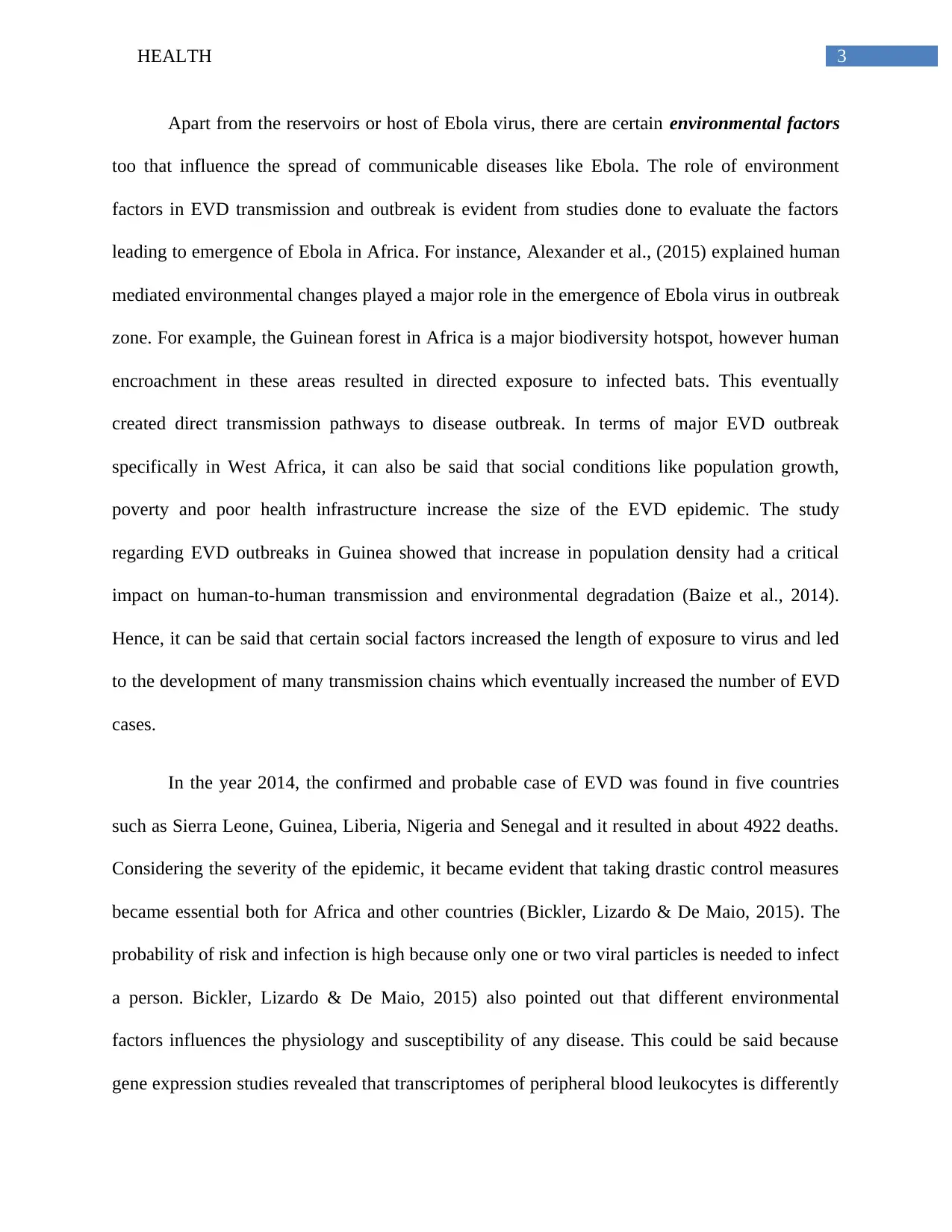
3HEALTH
Apart from the reservoirs or host of Ebola virus, there are certain environmental factors
too that influence the spread of communicable diseases like Ebola. The role of environment
factors in EVD transmission and outbreak is evident from studies done to evaluate the factors
leading to emergence of Ebola in Africa. For instance, Alexander et al., (2015) explained human
mediated environmental changes played a major role in the emergence of Ebola virus in outbreak
zone. For example, the Guinean forest in Africa is a major biodiversity hotspot, however human
encroachment in these areas resulted in directed exposure to infected bats. This eventually
created direct transmission pathways to disease outbreak. In terms of major EVD outbreak
specifically in West Africa, it can also be said that social conditions like population growth,
poverty and poor health infrastructure increase the size of the EVD epidemic. The study
regarding EVD outbreaks in Guinea showed that increase in population density had a critical
impact on human-to-human transmission and environmental degradation (Baize et al., 2014).
Hence, it can be said that certain social factors increased the length of exposure to virus and led
to the development of many transmission chains which eventually increased the number of EVD
cases.
In the year 2014, the confirmed and probable case of EVD was found in five countries
such as Sierra Leone, Guinea, Liberia, Nigeria and Senegal and it resulted in about 4922 deaths.
Considering the severity of the epidemic, it became evident that taking drastic control measures
became essential both for Africa and other countries (Bickler, Lizardo & De Maio, 2015). The
probability of risk and infection is high because only one or two viral particles is needed to infect
a person. Bickler, Lizardo & De Maio, 2015) also pointed out that different environmental
factors influences the physiology and susceptibility of any disease. This could be said because
gene expression studies revealed that transcriptomes of peripheral blood leukocytes is differently
Apart from the reservoirs or host of Ebola virus, there are certain environmental factors
too that influence the spread of communicable diseases like Ebola. The role of environment
factors in EVD transmission and outbreak is evident from studies done to evaluate the factors
leading to emergence of Ebola in Africa. For instance, Alexander et al., (2015) explained human
mediated environmental changes played a major role in the emergence of Ebola virus in outbreak
zone. For example, the Guinean forest in Africa is a major biodiversity hotspot, however human
encroachment in these areas resulted in directed exposure to infected bats. This eventually
created direct transmission pathways to disease outbreak. In terms of major EVD outbreak
specifically in West Africa, it can also be said that social conditions like population growth,
poverty and poor health infrastructure increase the size of the EVD epidemic. The study
regarding EVD outbreaks in Guinea showed that increase in population density had a critical
impact on human-to-human transmission and environmental degradation (Baize et al., 2014).
Hence, it can be said that certain social factors increased the length of exposure to virus and led
to the development of many transmission chains which eventually increased the number of EVD
cases.
In the year 2014, the confirmed and probable case of EVD was found in five countries
such as Sierra Leone, Guinea, Liberia, Nigeria and Senegal and it resulted in about 4922 deaths.
Considering the severity of the epidemic, it became evident that taking drastic control measures
became essential both for Africa and other countries (Bickler, Lizardo & De Maio, 2015). The
probability of risk and infection is high because only one or two viral particles is needed to infect
a person. Bickler, Lizardo & De Maio, 2015) also pointed out that different environmental
factors influences the physiology and susceptibility of any disease. This could be said because
gene expression studies revealed that transcriptomes of peripheral blood leukocytes is differently
Paraphrase This Document
Need a fresh take? Get an instant paraphrase of this document with our AI Paraphraser
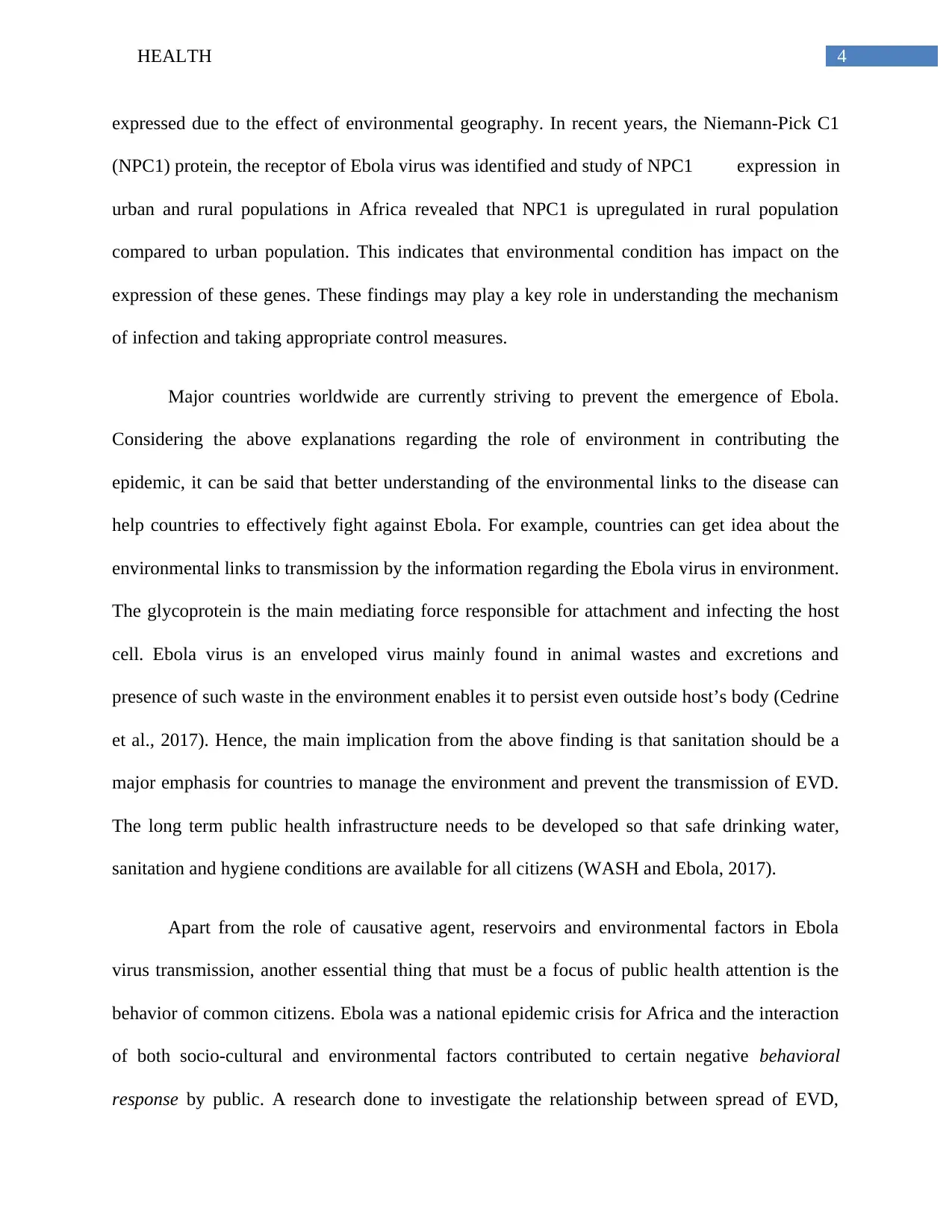
4HEALTH
expressed due to the effect of environmental geography. In recent years, the Niemann-Pick C1
(NPC1) protein, the receptor of Ebola virus was identified and study of NPC1 expression in
urban and rural populations in Africa revealed that NPC1 is upregulated in rural population
compared to urban population. This indicates that environmental condition has impact on the
expression of these genes. These findings may play a key role in understanding the mechanism
of infection and taking appropriate control measures.
Major countries worldwide are currently striving to prevent the emergence of Ebola.
Considering the above explanations regarding the role of environment in contributing the
epidemic, it can be said that better understanding of the environmental links to the disease can
help countries to effectively fight against Ebola. For example, countries can get idea about the
environmental links to transmission by the information regarding the Ebola virus in environment.
The glycoprotein is the main mediating force responsible for attachment and infecting the host
cell. Ebola virus is an enveloped virus mainly found in animal wastes and excretions and
presence of such waste in the environment enables it to persist even outside host’s body (Cedrine
et al., 2017). Hence, the main implication from the above finding is that sanitation should be a
major emphasis for countries to manage the environment and prevent the transmission of EVD.
The long term public health infrastructure needs to be developed so that safe drinking water,
sanitation and hygiene conditions are available for all citizens (WASH and Ebola, 2017).
Apart from the role of causative agent, reservoirs and environmental factors in Ebola
virus transmission, another essential thing that must be a focus of public health attention is the
behavior of common citizens. Ebola was a national epidemic crisis for Africa and the interaction
of both socio-cultural and environmental factors contributed to certain negative behavioral
response by public. A research done to investigate the relationship between spread of EVD,
expressed due to the effect of environmental geography. In recent years, the Niemann-Pick C1
(NPC1) protein, the receptor of Ebola virus was identified and study of NPC1 expression in
urban and rural populations in Africa revealed that NPC1 is upregulated in rural population
compared to urban population. This indicates that environmental condition has impact on the
expression of these genes. These findings may play a key role in understanding the mechanism
of infection and taking appropriate control measures.
Major countries worldwide are currently striving to prevent the emergence of Ebola.
Considering the above explanations regarding the role of environment in contributing the
epidemic, it can be said that better understanding of the environmental links to the disease can
help countries to effectively fight against Ebola. For example, countries can get idea about the
environmental links to transmission by the information regarding the Ebola virus in environment.
The glycoprotein is the main mediating force responsible for attachment and infecting the host
cell. Ebola virus is an enveloped virus mainly found in animal wastes and excretions and
presence of such waste in the environment enables it to persist even outside host’s body (Cedrine
et al., 2017). Hence, the main implication from the above finding is that sanitation should be a
major emphasis for countries to manage the environment and prevent the transmission of EVD.
The long term public health infrastructure needs to be developed so that safe drinking water,
sanitation and hygiene conditions are available for all citizens (WASH and Ebola, 2017).
Apart from the role of causative agent, reservoirs and environmental factors in Ebola
virus transmission, another essential thing that must be a focus of public health attention is the
behavior of common citizens. Ebola was a national epidemic crisis for Africa and the interaction
of both socio-cultural and environmental factors contributed to certain negative behavioral
response by public. A research done to investigate the relationship between spread of EVD,
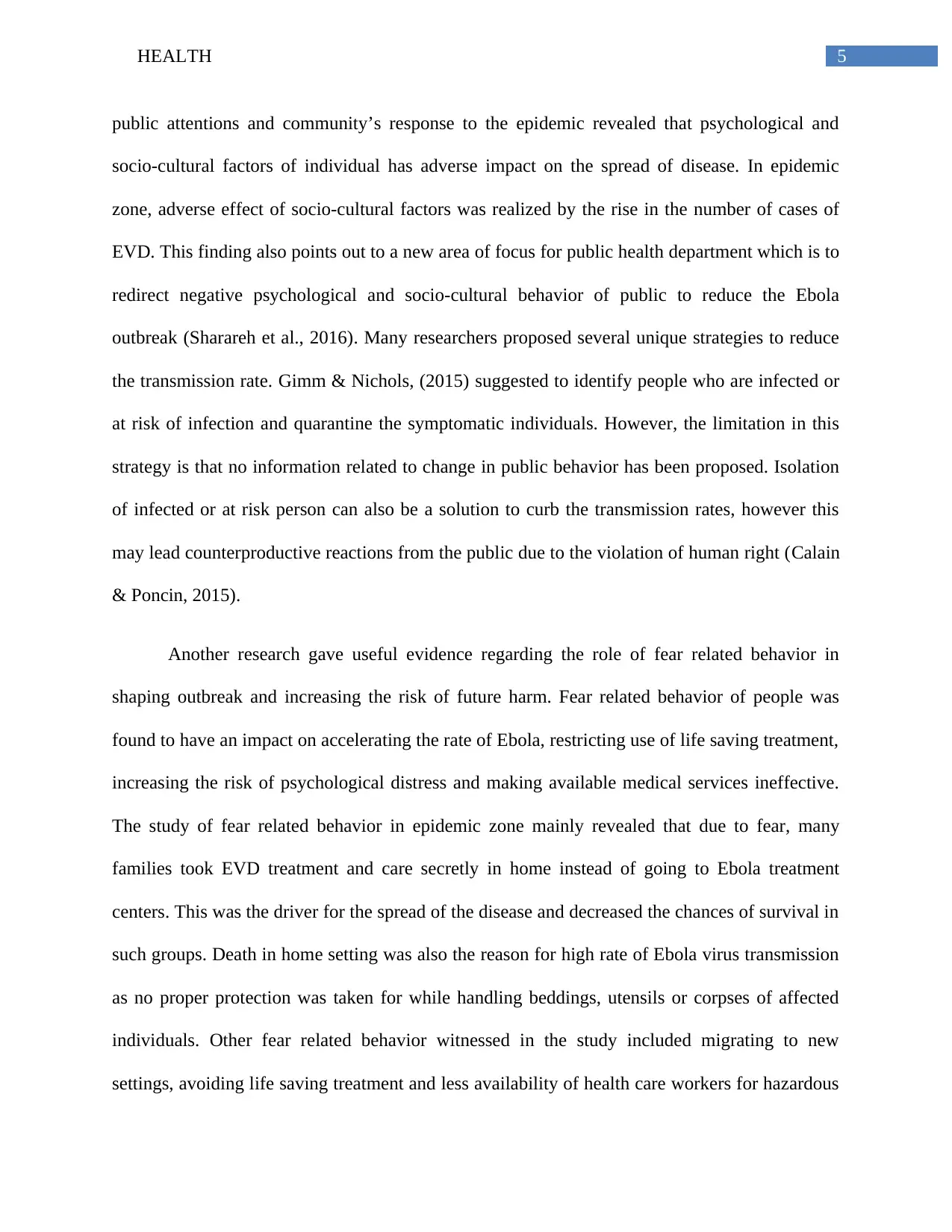
5HEALTH
public attentions and community’s response to the epidemic revealed that psychological and
socio-cultural factors of individual has adverse impact on the spread of disease. In epidemic
zone, adverse effect of socio-cultural factors was realized by the rise in the number of cases of
EVD. This finding also points out to a new area of focus for public health department which is to
redirect negative psychological and socio-cultural behavior of public to reduce the Ebola
outbreak (Sharareh et al., 2016). Many researchers proposed several unique strategies to reduce
the transmission rate. Gimm & Nichols, (2015) suggested to identify people who are infected or
at risk of infection and quarantine the symptomatic individuals. However, the limitation in this
strategy is that no information related to change in public behavior has been proposed. Isolation
of infected or at risk person can also be a solution to curb the transmission rates, however this
may lead counterproductive reactions from the public due to the violation of human right (Calain
& Poncin, 2015).
Another research gave useful evidence regarding the role of fear related behavior in
shaping outbreak and increasing the risk of future harm. Fear related behavior of people was
found to have an impact on accelerating the rate of Ebola, restricting use of life saving treatment,
increasing the risk of psychological distress and making available medical services ineffective.
The study of fear related behavior in epidemic zone mainly revealed that due to fear, many
families took EVD treatment and care secretly in home instead of going to Ebola treatment
centers. This was the driver for the spread of the disease and decreased the chances of survival in
such groups. Death in home setting was also the reason for high rate of Ebola virus transmission
as no proper protection was taken for while handling beddings, utensils or corpses of affected
individuals. Other fear related behavior witnessed in the study included migrating to new
settings, avoiding life saving treatment and less availability of health care workers for hazardous
public attentions and community’s response to the epidemic revealed that psychological and
socio-cultural factors of individual has adverse impact on the spread of disease. In epidemic
zone, adverse effect of socio-cultural factors was realized by the rise in the number of cases of
EVD. This finding also points out to a new area of focus for public health department which is to
redirect negative psychological and socio-cultural behavior of public to reduce the Ebola
outbreak (Sharareh et al., 2016). Many researchers proposed several unique strategies to reduce
the transmission rate. Gimm & Nichols, (2015) suggested to identify people who are infected or
at risk of infection and quarantine the symptomatic individuals. However, the limitation in this
strategy is that no information related to change in public behavior has been proposed. Isolation
of infected or at risk person can also be a solution to curb the transmission rates, however this
may lead counterproductive reactions from the public due to the violation of human right (Calain
& Poncin, 2015).
Another research gave useful evidence regarding the role of fear related behavior in
shaping outbreak and increasing the risk of future harm. Fear related behavior of people was
found to have an impact on accelerating the rate of Ebola, restricting use of life saving treatment,
increasing the risk of psychological distress and making available medical services ineffective.
The study of fear related behavior in epidemic zone mainly revealed that due to fear, many
families took EVD treatment and care secretly in home instead of going to Ebola treatment
centers. This was the driver for the spread of the disease and decreased the chances of survival in
such groups. Death in home setting was also the reason for high rate of Ebola virus transmission
as no proper protection was taken for while handling beddings, utensils or corpses of affected
individuals. Other fear related behavior witnessed in the study included migrating to new
settings, avoiding life saving treatment and less availability of health care workers for hazardous
⊘ This is a preview!⊘
Do you want full access?
Subscribe today to unlock all pages.

Trusted by 1+ million students worldwide
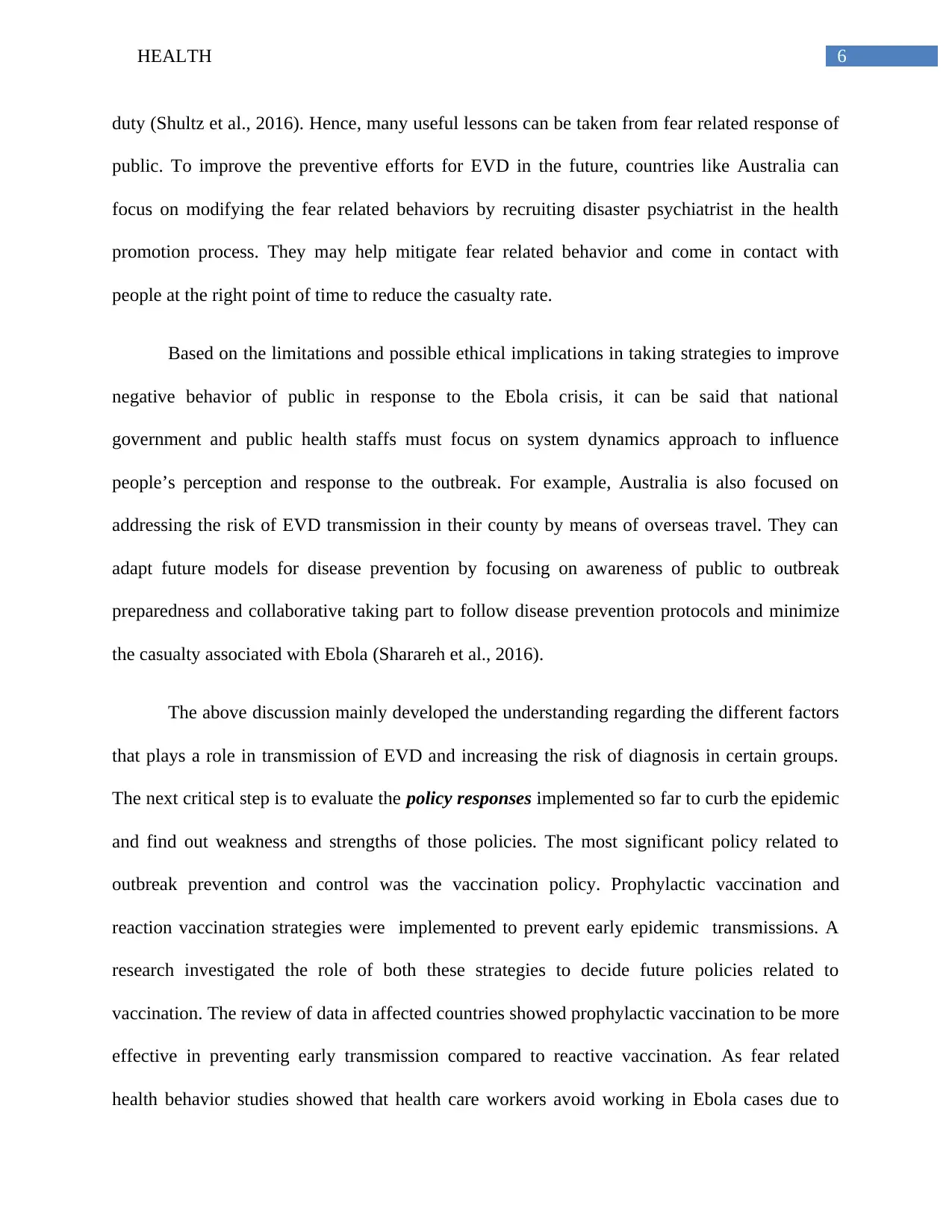
6HEALTH
duty (Shultz et al., 2016). Hence, many useful lessons can be taken from fear related response of
public. To improve the preventive efforts for EVD in the future, countries like Australia can
focus on modifying the fear related behaviors by recruiting disaster psychiatrist in the health
promotion process. They may help mitigate fear related behavior and come in contact with
people at the right point of time to reduce the casualty rate.
Based on the limitations and possible ethical implications in taking strategies to improve
negative behavior of public in response to the Ebola crisis, it can be said that national
government and public health staffs must focus on system dynamics approach to influence
people’s perception and response to the outbreak. For example, Australia is also focused on
addressing the risk of EVD transmission in their county by means of overseas travel. They can
adapt future models for disease prevention by focusing on awareness of public to outbreak
preparedness and collaborative taking part to follow disease prevention protocols and minimize
the casualty associated with Ebola (Sharareh et al., 2016).
The above discussion mainly developed the understanding regarding the different factors
that plays a role in transmission of EVD and increasing the risk of diagnosis in certain groups.
The next critical step is to evaluate the policy responses implemented so far to curb the epidemic
and find out weakness and strengths of those policies. The most significant policy related to
outbreak prevention and control was the vaccination policy. Prophylactic vaccination and
reaction vaccination strategies were implemented to prevent early epidemic transmissions. A
research investigated the role of both these strategies to decide future policies related to
vaccination. The review of data in affected countries showed prophylactic vaccination to be more
effective in preventing early transmission compared to reactive vaccination. As fear related
health behavior studies showed that health care workers avoid working in Ebola cases due to
duty (Shultz et al., 2016). Hence, many useful lessons can be taken from fear related response of
public. To improve the preventive efforts for EVD in the future, countries like Australia can
focus on modifying the fear related behaviors by recruiting disaster psychiatrist in the health
promotion process. They may help mitigate fear related behavior and come in contact with
people at the right point of time to reduce the casualty rate.
Based on the limitations and possible ethical implications in taking strategies to improve
negative behavior of public in response to the Ebola crisis, it can be said that national
government and public health staffs must focus on system dynamics approach to influence
people’s perception and response to the outbreak. For example, Australia is also focused on
addressing the risk of EVD transmission in their county by means of overseas travel. They can
adapt future models for disease prevention by focusing on awareness of public to outbreak
preparedness and collaborative taking part to follow disease prevention protocols and minimize
the casualty associated with Ebola (Sharareh et al., 2016).
The above discussion mainly developed the understanding regarding the different factors
that plays a role in transmission of EVD and increasing the risk of diagnosis in certain groups.
The next critical step is to evaluate the policy responses implemented so far to curb the epidemic
and find out weakness and strengths of those policies. The most significant policy related to
outbreak prevention and control was the vaccination policy. Prophylactic vaccination and
reaction vaccination strategies were implemented to prevent early epidemic transmissions. A
research investigated the role of both these strategies to decide future policies related to
vaccination. The review of data in affected countries showed prophylactic vaccination to be more
effective in preventing early transmission compared to reactive vaccination. As fear related
health behavior studies showed that health care workers avoid working in Ebola cases due to
Paraphrase This Document
Need a fresh take? Get an instant paraphrase of this document with our AI Paraphraser
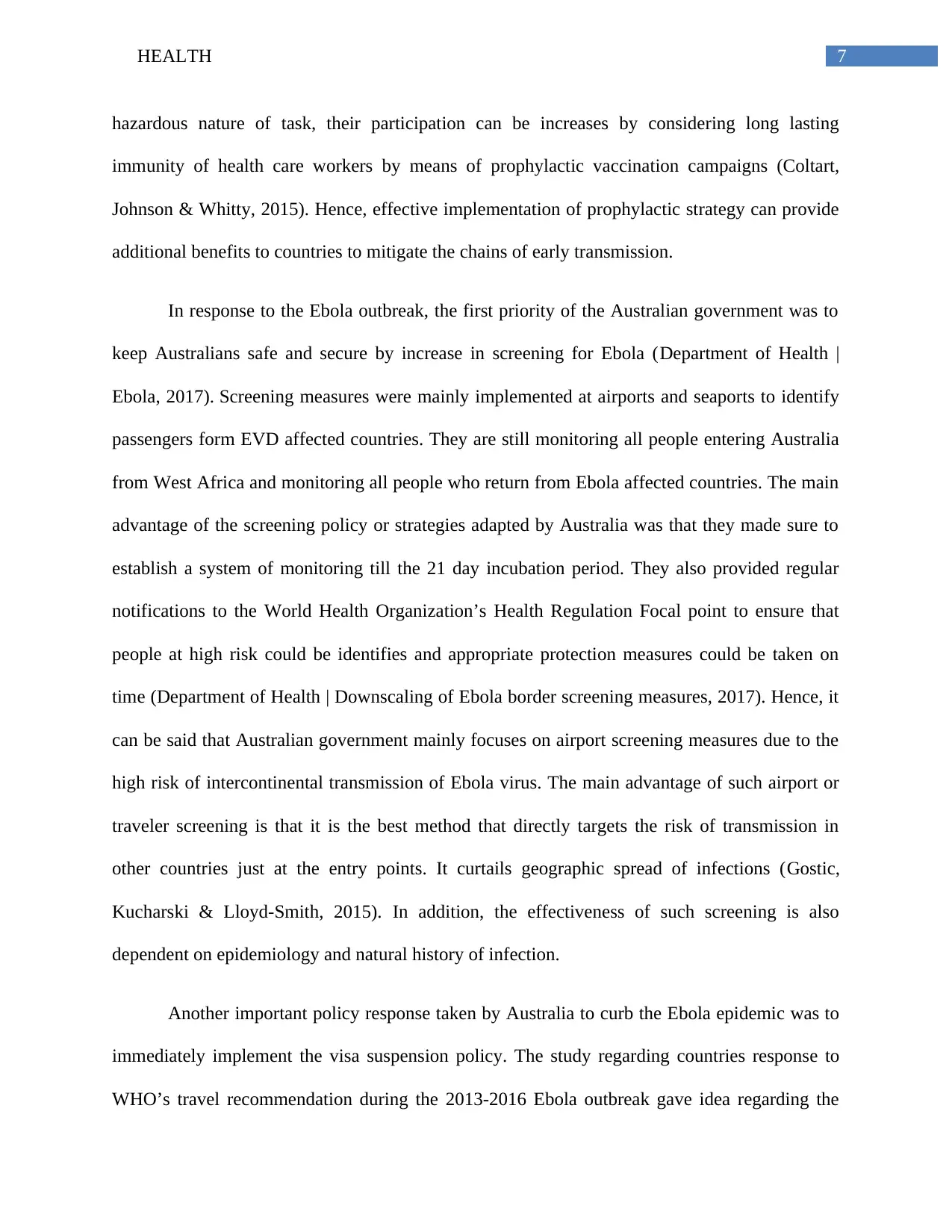
7HEALTH
hazardous nature of task, their participation can be increases by considering long lasting
immunity of health care workers by means of prophylactic vaccination campaigns (Coltart,
Johnson & Whitty, 2015). Hence, effective implementation of prophylactic strategy can provide
additional benefits to countries to mitigate the chains of early transmission.
In response to the Ebola outbreak, the first priority of the Australian government was to
keep Australians safe and secure by increase in screening for Ebola (Department of Health |
Ebola, 2017). Screening measures were mainly implemented at airports and seaports to identify
passengers form EVD affected countries. They are still monitoring all people entering Australia
from West Africa and monitoring all people who return from Ebola affected countries. The main
advantage of the screening policy or strategies adapted by Australia was that they made sure to
establish a system of monitoring till the 21 day incubation period. They also provided regular
notifications to the World Health Organization’s Health Regulation Focal point to ensure that
people at high risk could be identifies and appropriate protection measures could be taken on
time (Department of Health | Downscaling of Ebola border screening measures, 2017). Hence, it
can be said that Australian government mainly focuses on airport screening measures due to the
high risk of intercontinental transmission of Ebola virus. The main advantage of such airport or
traveler screening is that it is the best method that directly targets the risk of transmission in
other countries just at the entry points. It curtails geographic spread of infections (Gostic,
Kucharski & Lloyd-Smith, 2015). In addition, the effectiveness of such screening is also
dependent on epidemiology and natural history of infection.
Another important policy response taken by Australia to curb the Ebola epidemic was to
immediately implement the visa suspension policy. The study regarding countries response to
WHO’s travel recommendation during the 2013-2016 Ebola outbreak gave idea regarding the
hazardous nature of task, their participation can be increases by considering long lasting
immunity of health care workers by means of prophylactic vaccination campaigns (Coltart,
Johnson & Whitty, 2015). Hence, effective implementation of prophylactic strategy can provide
additional benefits to countries to mitigate the chains of early transmission.
In response to the Ebola outbreak, the first priority of the Australian government was to
keep Australians safe and secure by increase in screening for Ebola (Department of Health |
Ebola, 2017). Screening measures were mainly implemented at airports and seaports to identify
passengers form EVD affected countries. They are still monitoring all people entering Australia
from West Africa and monitoring all people who return from Ebola affected countries. The main
advantage of the screening policy or strategies adapted by Australia was that they made sure to
establish a system of monitoring till the 21 day incubation period. They also provided regular
notifications to the World Health Organization’s Health Regulation Focal point to ensure that
people at high risk could be identifies and appropriate protection measures could be taken on
time (Department of Health | Downscaling of Ebola border screening measures, 2017). Hence, it
can be said that Australian government mainly focuses on airport screening measures due to the
high risk of intercontinental transmission of Ebola virus. The main advantage of such airport or
traveler screening is that it is the best method that directly targets the risk of transmission in
other countries just at the entry points. It curtails geographic spread of infections (Gostic,
Kucharski & Lloyd-Smith, 2015). In addition, the effectiveness of such screening is also
dependent on epidemiology and natural history of infection.
Another important policy response taken by Australia to curb the Ebola epidemic was to
immediately implement the visa suspension policy. The study regarding countries response to
WHO’s travel recommendation during the 2013-2016 Ebola outbreak gave idea regarding the
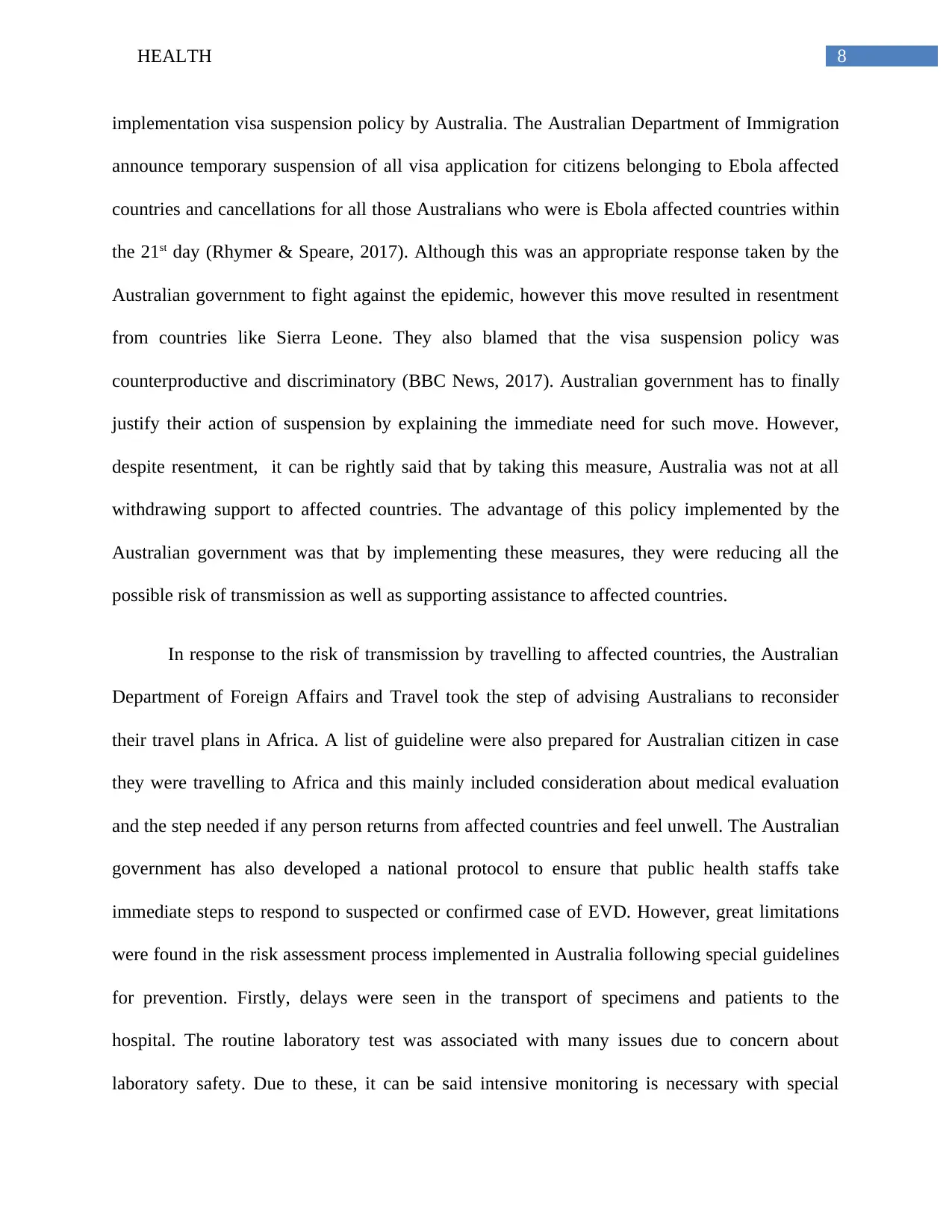
8HEALTH
implementation visa suspension policy by Australia. The Australian Department of Immigration
announce temporary suspension of all visa application for citizens belonging to Ebola affected
countries and cancellations for all those Australians who were is Ebola affected countries within
the 21st day (Rhymer & Speare, 2017). Although this was an appropriate response taken by the
Australian government to fight against the epidemic, however this move resulted in resentment
from countries like Sierra Leone. They also blamed that the visa suspension policy was
counterproductive and discriminatory (BBC News, 2017). Australian government has to finally
justify their action of suspension by explaining the immediate need for such move. However,
despite resentment, it can be rightly said that by taking this measure, Australia was not at all
withdrawing support to affected countries. The advantage of this policy implemented by the
Australian government was that by implementing these measures, they were reducing all the
possible risk of transmission as well as supporting assistance to affected countries.
In response to the risk of transmission by travelling to affected countries, the Australian
Department of Foreign Affairs and Travel took the step of advising Australians to reconsider
their travel plans in Africa. A list of guideline were also prepared for Australian citizen in case
they were travelling to Africa and this mainly included consideration about medical evaluation
and the step needed if any person returns from affected countries and feel unwell. The Australian
government has also developed a national protocol to ensure that public health staffs take
immediate steps to respond to suspected or confirmed case of EVD. However, great limitations
were found in the risk assessment process implemented in Australia following special guidelines
for prevention. Firstly, delays were seen in the transport of specimens and patients to the
hospital. The routine laboratory test was associated with many issues due to concern about
laboratory safety. Due to these, it can be said intensive monitoring is necessary with special
implementation visa suspension policy by Australia. The Australian Department of Immigration
announce temporary suspension of all visa application for citizens belonging to Ebola affected
countries and cancellations for all those Australians who were is Ebola affected countries within
the 21st day (Rhymer & Speare, 2017). Although this was an appropriate response taken by the
Australian government to fight against the epidemic, however this move resulted in resentment
from countries like Sierra Leone. They also blamed that the visa suspension policy was
counterproductive and discriminatory (BBC News, 2017). Australian government has to finally
justify their action of suspension by explaining the immediate need for such move. However,
despite resentment, it can be rightly said that by taking this measure, Australia was not at all
withdrawing support to affected countries. The advantage of this policy implemented by the
Australian government was that by implementing these measures, they were reducing all the
possible risk of transmission as well as supporting assistance to affected countries.
In response to the risk of transmission by travelling to affected countries, the Australian
Department of Foreign Affairs and Travel took the step of advising Australians to reconsider
their travel plans in Africa. A list of guideline were also prepared for Australian citizen in case
they were travelling to Africa and this mainly included consideration about medical evaluation
and the step needed if any person returns from affected countries and feel unwell. The Australian
government has also developed a national protocol to ensure that public health staffs take
immediate steps to respond to suspected or confirmed case of EVD. However, great limitations
were found in the risk assessment process implemented in Australia following special guidelines
for prevention. Firstly, delays were seen in the transport of specimens and patients to the
hospital. The routine laboratory test was associated with many issues due to concern about
laboratory safety. Due to these, it can be said intensive monitoring is necessary with special
⊘ This is a preview!⊘
Do you want full access?
Subscribe today to unlock all pages.

Trusted by 1+ million students worldwide
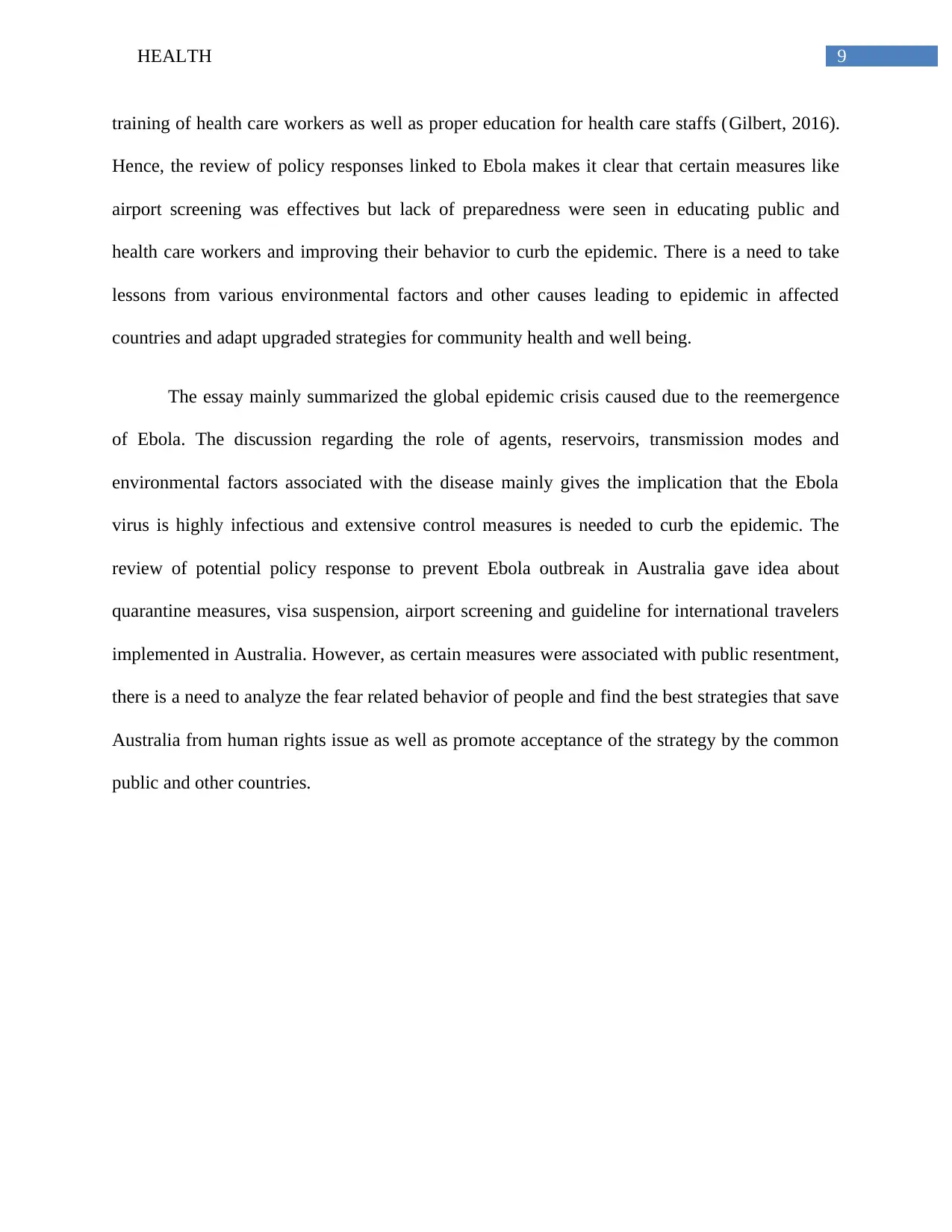
9HEALTH
training of health care workers as well as proper education for health care staffs (Gilbert, 2016).
Hence, the review of policy responses linked to Ebola makes it clear that certain measures like
airport screening was effectives but lack of preparedness were seen in educating public and
health care workers and improving their behavior to curb the epidemic. There is a need to take
lessons from various environmental factors and other causes leading to epidemic in affected
countries and adapt upgraded strategies for community health and well being.
The essay mainly summarized the global epidemic crisis caused due to the reemergence
of Ebola. The discussion regarding the role of agents, reservoirs, transmission modes and
environmental factors associated with the disease mainly gives the implication that the Ebola
virus is highly infectious and extensive control measures is needed to curb the epidemic. The
review of potential policy response to prevent Ebola outbreak in Australia gave idea about
quarantine measures, visa suspension, airport screening and guideline for international travelers
implemented in Australia. However, as certain measures were associated with public resentment,
there is a need to analyze the fear related behavior of people and find the best strategies that save
Australia from human rights issue as well as promote acceptance of the strategy by the common
public and other countries.
training of health care workers as well as proper education for health care staffs (Gilbert, 2016).
Hence, the review of policy responses linked to Ebola makes it clear that certain measures like
airport screening was effectives but lack of preparedness were seen in educating public and
health care workers and improving their behavior to curb the epidemic. There is a need to take
lessons from various environmental factors and other causes leading to epidemic in affected
countries and adapt upgraded strategies for community health and well being.
The essay mainly summarized the global epidemic crisis caused due to the reemergence
of Ebola. The discussion regarding the role of agents, reservoirs, transmission modes and
environmental factors associated with the disease mainly gives the implication that the Ebola
virus is highly infectious and extensive control measures is needed to curb the epidemic. The
review of potential policy response to prevent Ebola outbreak in Australia gave idea about
quarantine measures, visa suspension, airport screening and guideline for international travelers
implemented in Australia. However, as certain measures were associated with public resentment,
there is a need to analyze the fear related behavior of people and find the best strategies that save
Australia from human rights issue as well as promote acceptance of the strategy by the common
public and other countries.
Paraphrase This Document
Need a fresh take? Get an instant paraphrase of this document with our AI Paraphraser
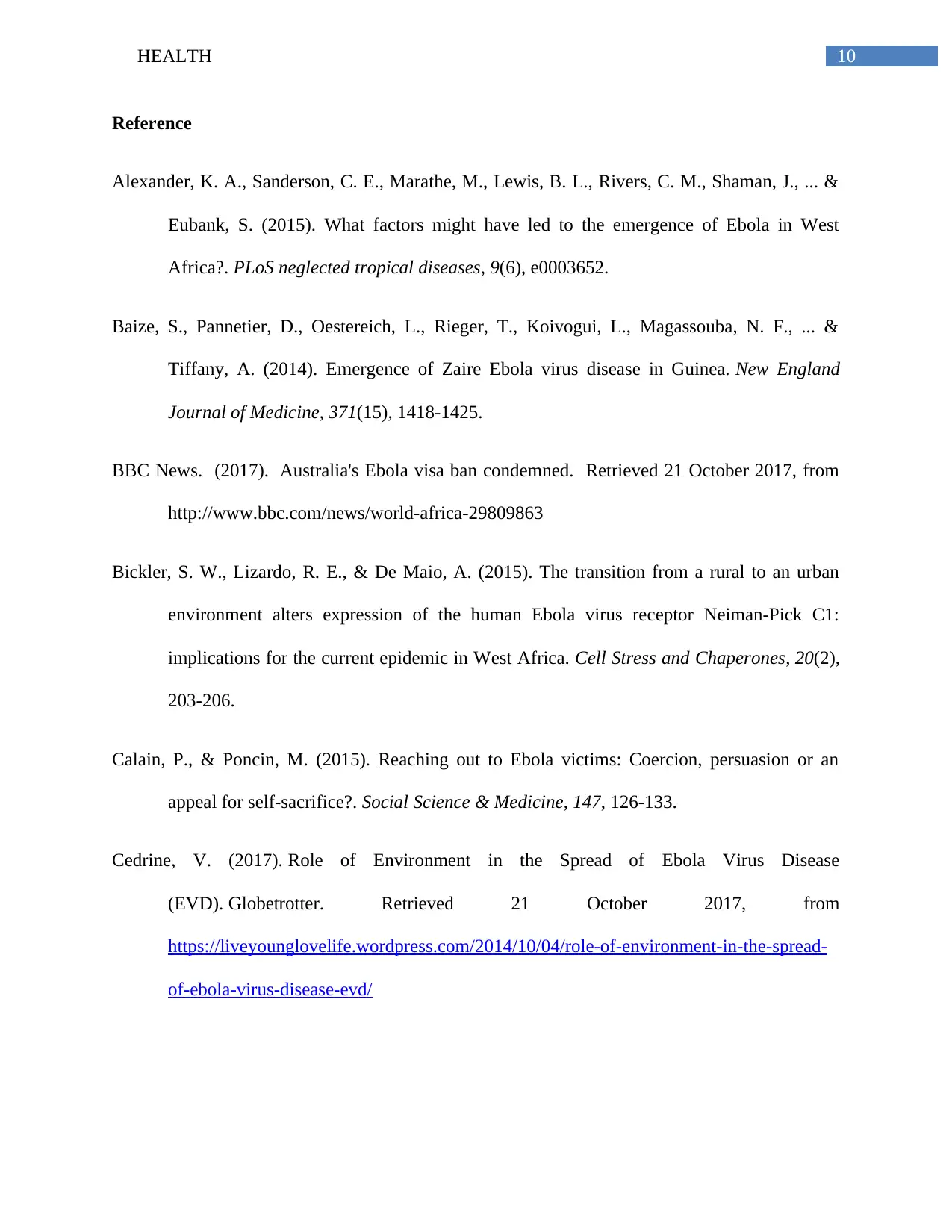
10HEALTH
Reference
Alexander, K. A., Sanderson, C. E., Marathe, M., Lewis, B. L., Rivers, C. M., Shaman, J., ... &
Eubank, S. (2015). What factors might have led to the emergence of Ebola in West
Africa?. PLoS neglected tropical diseases, 9(6), e0003652.
Baize, S., Pannetier, D., Oestereich, L., Rieger, T., Koivogui, L., Magassouba, N. F., ... &
Tiffany, A. (2014). Emergence of Zaire Ebola virus disease in Guinea. New England
Journal of Medicine, 371(15), 1418-1425.
BBC News. (2017). Australia's Ebola visa ban condemned. Retrieved 21 October 2017, from
http://www.bbc.com/news/world-africa-29809863
Bickler, S. W., Lizardo, R. E., & De Maio, A. (2015). The transition from a rural to an urban
environment alters expression of the human Ebola virus receptor Neiman-Pick C1:
implications for the current epidemic in West Africa. Cell Stress and Chaperones, 20(2),
203-206.
Calain, P., & Poncin, M. (2015). Reaching out to Ebola victims: Coercion, persuasion or an
appeal for self-sacrifice?. Social Science & Medicine, 147, 126-133.
Cedrine, V. (2017). Role of Environment in the Spread of Ebola Virus Disease
(EVD). Globetrotter. Retrieved 21 October 2017, from
https://liveyounglovelife.wordpress.com/2014/10/04/role-of-environment-in-the-spread-
of-ebola-virus-disease-evd/
Reference
Alexander, K. A., Sanderson, C. E., Marathe, M., Lewis, B. L., Rivers, C. M., Shaman, J., ... &
Eubank, S. (2015). What factors might have led to the emergence of Ebola in West
Africa?. PLoS neglected tropical diseases, 9(6), e0003652.
Baize, S., Pannetier, D., Oestereich, L., Rieger, T., Koivogui, L., Magassouba, N. F., ... &
Tiffany, A. (2014). Emergence of Zaire Ebola virus disease in Guinea. New England
Journal of Medicine, 371(15), 1418-1425.
BBC News. (2017). Australia's Ebola visa ban condemned. Retrieved 21 October 2017, from
http://www.bbc.com/news/world-africa-29809863
Bickler, S. W., Lizardo, R. E., & De Maio, A. (2015). The transition from a rural to an urban
environment alters expression of the human Ebola virus receptor Neiman-Pick C1:
implications for the current epidemic in West Africa. Cell Stress and Chaperones, 20(2),
203-206.
Calain, P., & Poncin, M. (2015). Reaching out to Ebola victims: Coercion, persuasion or an
appeal for self-sacrifice?. Social Science & Medicine, 147, 126-133.
Cedrine, V. (2017). Role of Environment in the Spread of Ebola Virus Disease
(EVD). Globetrotter. Retrieved 21 October 2017, from
https://liveyounglovelife.wordpress.com/2014/10/04/role-of-environment-in-the-spread-
of-ebola-virus-disease-evd/
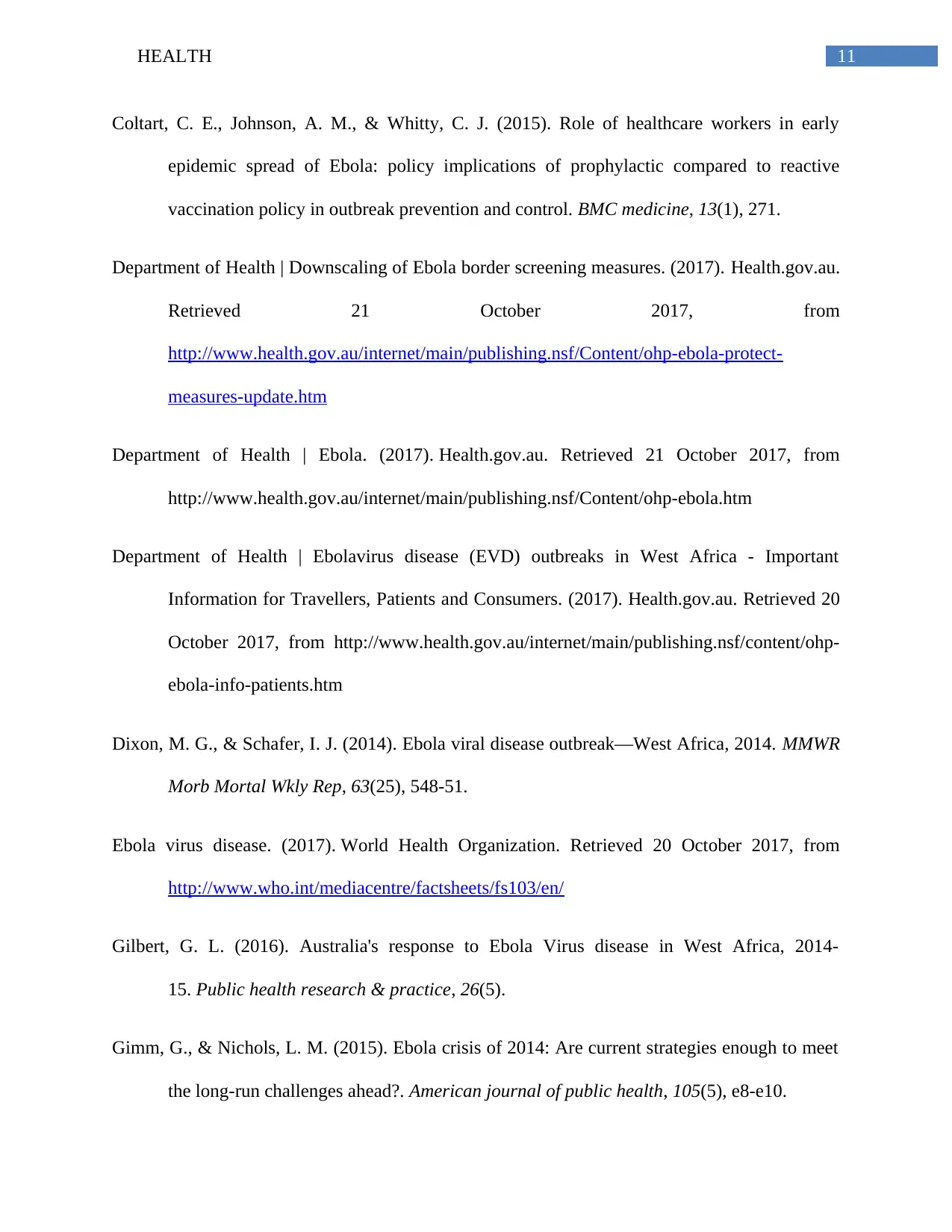
11HEALTH
Coltart, C. E., Johnson, A. M., & Whitty, C. J. (2015). Role of healthcare workers in early
epidemic spread of Ebola: policy implications of prophylactic compared to reactive
vaccination policy in outbreak prevention and control. BMC medicine, 13(1), 271.
Department of Health | Downscaling of Ebola border screening measures. (2017). Health.gov.au.
Retrieved 21 October 2017, from
http://www.health.gov.au/internet/main/publishing.nsf/Content/ohp-ebola-protect-
measures-update.htm
Department of Health | Ebola. (2017). Health.gov.au. Retrieved 21 October 2017, from
http://www.health.gov.au/internet/main/publishing.nsf/Content/ohp-ebola.htm
Department of Health | Ebolavirus disease (EVD) outbreaks in West Africa - Important
Information for Travellers, Patients and Consumers. (2017). Health.gov.au. Retrieved 20
October 2017, from http://www.health.gov.au/internet/main/publishing.nsf/content/ohp-
ebola-info-patients.htm
Dixon, M. G., & Schafer, I. J. (2014). Ebola viral disease outbreak—West Africa, 2014. MMWR
Morb Mortal Wkly Rep, 63(25), 548-51.
Ebola virus disease. (2017). World Health Organization. Retrieved 20 October 2017, from
http://www.who.int/mediacentre/factsheets/fs103/en/
Gilbert, G. L. (2016). Australia's response to Ebola Virus disease in West Africa, 2014-
15. Public health research & practice, 26(5).
Gimm, G., & Nichols, L. M. (2015). Ebola crisis of 2014: Are current strategies enough to meet
the long-run challenges ahead?. American journal of public health, 105(5), e8-e10.
Coltart, C. E., Johnson, A. M., & Whitty, C. J. (2015). Role of healthcare workers in early
epidemic spread of Ebola: policy implications of prophylactic compared to reactive
vaccination policy in outbreak prevention and control. BMC medicine, 13(1), 271.
Department of Health | Downscaling of Ebola border screening measures. (2017). Health.gov.au.
Retrieved 21 October 2017, from
http://www.health.gov.au/internet/main/publishing.nsf/Content/ohp-ebola-protect-
measures-update.htm
Department of Health | Ebola. (2017). Health.gov.au. Retrieved 21 October 2017, from
http://www.health.gov.au/internet/main/publishing.nsf/Content/ohp-ebola.htm
Department of Health | Ebolavirus disease (EVD) outbreaks in West Africa - Important
Information for Travellers, Patients and Consumers. (2017). Health.gov.au. Retrieved 20
October 2017, from http://www.health.gov.au/internet/main/publishing.nsf/content/ohp-
ebola-info-patients.htm
Dixon, M. G., & Schafer, I. J. (2014). Ebola viral disease outbreak—West Africa, 2014. MMWR
Morb Mortal Wkly Rep, 63(25), 548-51.
Ebola virus disease. (2017). World Health Organization. Retrieved 20 October 2017, from
http://www.who.int/mediacentre/factsheets/fs103/en/
Gilbert, G. L. (2016). Australia's response to Ebola Virus disease in West Africa, 2014-
15. Public health research & practice, 26(5).
Gimm, G., & Nichols, L. M. (2015). Ebola crisis of 2014: Are current strategies enough to meet
the long-run challenges ahead?. American journal of public health, 105(5), e8-e10.
⊘ This is a preview!⊘
Do you want full access?
Subscribe today to unlock all pages.

Trusted by 1+ million students worldwide
1 out of 14
Related Documents
Your All-in-One AI-Powered Toolkit for Academic Success.
+13062052269
info@desklib.com
Available 24*7 on WhatsApp / Email
![[object Object]](/_next/static/media/star-bottom.7253800d.svg)
Unlock your academic potential
Copyright © 2020–2025 A2Z Services. All Rights Reserved. Developed and managed by ZUCOL.




